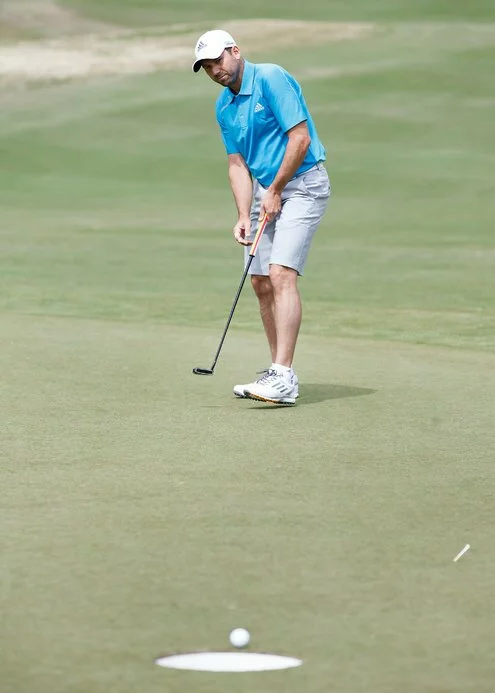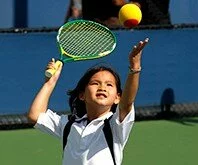Think Tennis Hate is Bad? Golf Hate is Worse
 Amy Eddings Posted on
Amy Eddings Posted on  Sunday, April 20, 2014 at 10:14AM
Sunday, April 20, 2014 at 10:14AM
Sometimes, the Hate half of my seesaw relationship with tennis soars higher than my Love, and I feel like quitting altogether and taking up another activity. It'd better not be golf. Frustration with that sport has people walking away in droves.
 Okay, now give me a big soccer-sized ball to hit. And a baseball bat for a club. Photo, courtesy of Associated Press/Paul Abell.
Okay, now give me a big soccer-sized ball to hit. And a baseball bat for a club. Photo, courtesy of Associated Press/Paul Abell.
A New York Times article notes that, by the National Golf Foundation's own estimates, five million golfers have bent their clubs over their knees and have walked off (or hobbled, depending on how that club-bending knee jab went). The NGF estimates about 20 percent of the 25 million existing golfers will do the same in the next few years.
"People under 35 have especially spurned the game, saying it takes too long to play, is too difficult to learn and has too many tiresome rules," wrote the Times' Bill Pennington.
Golf and tennis share a lot of Hate. These sports aren't easy.
Golf and tennis are often compared. They're both games for life. You can play from 8 to 80. They have codes of conduct, an etiquette that is not evident in hockey, football, basketball or soccer. Both are traditionally country club sports, with tennis doing a much better job of increasing its diversity. Quick, name another black American golfer besides Tiger Woods. Now, think of tennis: Serena, Venus, Sloane, James Blake, Donald Young, with junior champion Taylor Townsend lurking in the wings.
And golf and tennis share a lot of Hate. These sports are not easy. The defending United States Open champion (golf, not tennis), Justin Rose, told the Times his five-year-old son doesn't want to play anymore because he's tired of failing at it.
The United States Tennis Association saw a similar problem and is about five years into an effort to reverse it with its 10 and Under Tennis program, once called QuickStart. It promotes the use of big foam balls, shorter nets and smaller courts, so that kids can hit more easily and rally longer, and, presumably, boost their satisfaction level so that they stay with the sport. To encourage -- others might say force -- notoriously independent American teaching pros to adapt, the USTA changed the rules for junior tournaments so that they required the foam balls and smaller courts. In 2010, when I reported on this for WNYC, only 50,000 of the two to three million kids taking tennis clinics went on to participate in USTA junior-level matches. Meanwhile, adults were coming to tennis in droves; 350,000 were participating in USTA leagues.
"Very few sports have more adults playing than kids, but tennis is one of those," the USTA's chief executive of community tennis, Kurt Kamperman, told me then. "We want to turn that upside down. We want to keep all the adults, but we really want to see a kids' revolution."
How is golf dealing with its crisis of Hate? It's turning to tennis.
Yo, USTA, what about also working with what you have, which is an adult revolution? Why not try innovative ways to help adults find more satisfaction with tennis and play more? Why not give them more opportunities to compete, rather than the few open tournaments offered in which a 3.0 player can find herself playing a 5.0 club pro? Ah, a rant for another time.
 Photo, courtesy of USTA.com.In the meantime, there's been a lot of ranting against Ten and Under Tennis, especially since the USTA changed the rules for junior tournaments in 2011 to require foam balls and smaller courts. That has rankled some parents and teaching pros, who don't want to get with the program. They've included Fox commentator Sean Hannity, who has two kids in the junior tennis circuit, and teaching great Wayne Bryan, father of doubles living legends Bob and Mike. The backlash has been so fierce on social media that the USTA had to convene a pow-wow with Bryan and other top dissenters in 2012 to calm things down.
Photo, courtesy of USTA.com.In the meantime, there's been a lot of ranting against Ten and Under Tennis, especially since the USTA changed the rules for junior tournaments in 2011 to require foam balls and smaller courts. That has rankled some parents and teaching pros, who don't want to get with the program. They've included Fox commentator Sean Hannity, who has two kids in the junior tennis circuit, and teaching great Wayne Bryan, father of doubles living legends Bob and Mike. The backlash has been so fierce on social media that the USTA had to convene a pow-wow with Bryan and other top dissenters in 2012 to calm things down.
How will golf address its crisis of Hate? They're turning to tennis. According to the Times, the PGA has put together an "eclectic" 10-member advisory panel that includes former USTA exec Arlen Kanterian, "who led American tennis’s successful effort to reverse a decline in participation." He was gone in 2008, a few years before Ten and Under started getting actively promoted, but hey, he's the guy to go to if the USGA and PGA want to find ways to boost revenue and audience. During his 8 years as chief exec of pro tennis at the USTA, Kanterian brought in instant replay, blue courts, a Sunday women's US Open final and Patrick McEnroe as head of player development. And folks are STILL griping about the woeful state of American tennis, especially on the men's side.
Some golf leaders, including pro Sergio Garcia and golf-ball maker executive Mark King of TaylorMade-Adidas Golf, are suggesting a Ten and Under-style shift for golf, too, for youngsters and adult Golf Haters alike. They include changes to courses like "pizza-sized" 15-inch holes, juiced balls, shorter rounds, tees for every shot and mulligans for every hole. There are some who are even trying "foot golf," an unholy alliance of soccer and golf that involves kicking a ball into a hole. Time to do a Johnny Mac here and exclaim, "You cannot be serious!"
Some golf purists are hoping they aren't. In fact, they're counting on it.
“I don’t want to rig the game and cheapen it,” said Curtis Strange, a two-time United States Open champion and an analyst for ESPN. “I don’t like any of that stuff. And it’s not going to happen either. It’s all talk.”
 PGA,
PGA,  Ten and Under Tennis,
Ten and Under Tennis,  USGA,
USGA,  USTA,
USTA,  bigger holes for golf,
bigger holes for golf,  changes to golf,
changes to golf,  golf considers digging a wider hole,
golf considers digging a wider hole,  golf hate,
golf hate,  new york times,
new york times,  tennis hate | in
tennis hate | in  USTA,
USTA,  tennis hate
tennis hate

